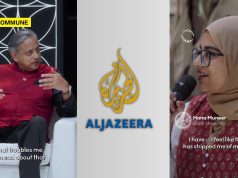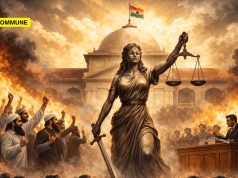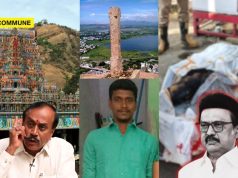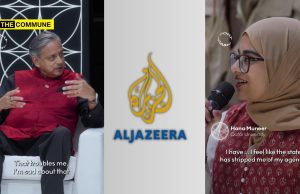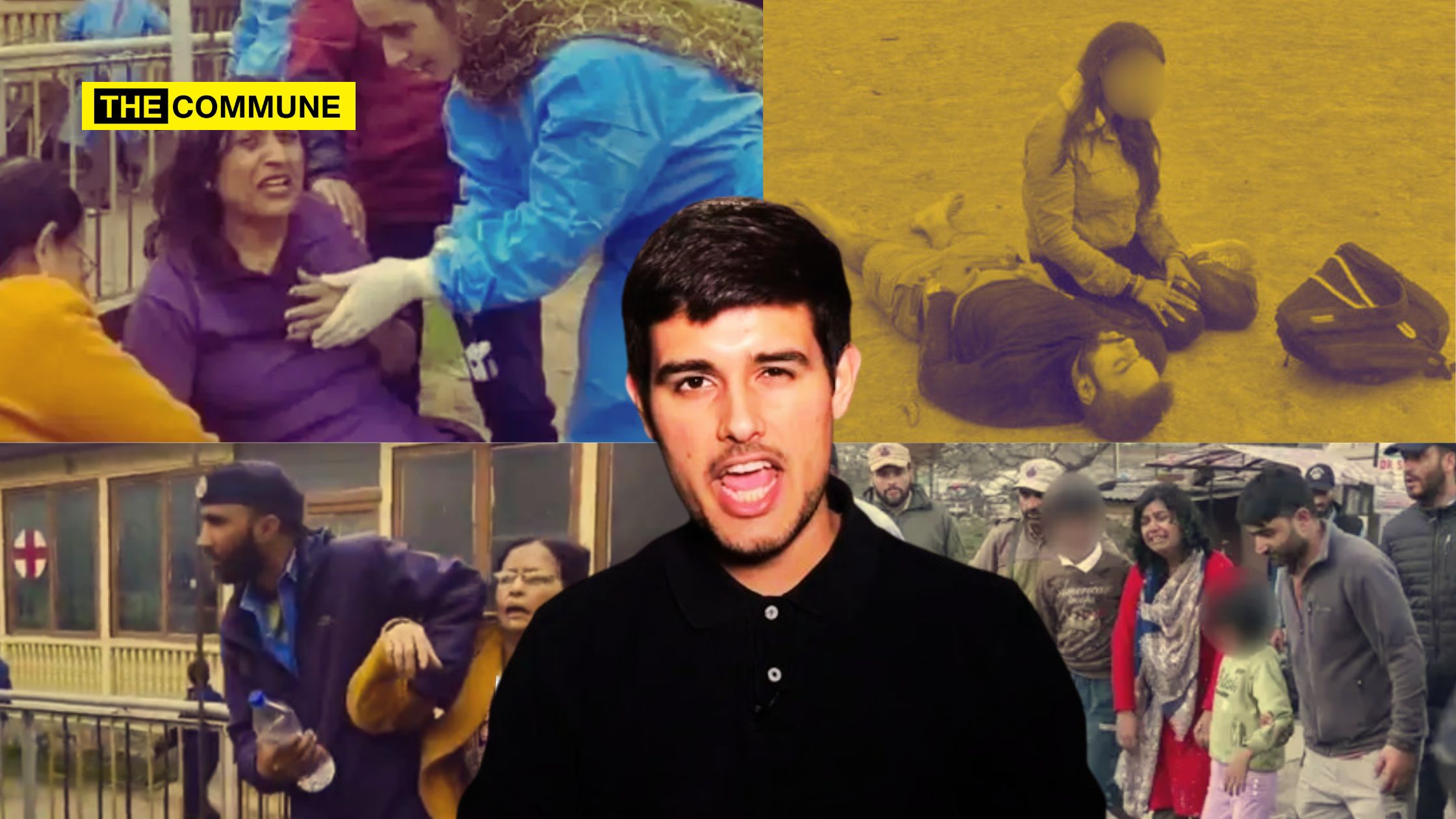
After the horrific terrorist attack in Pahalgam on 22 April 2025 which left 26 innocent people dead in Anantnag, Jammu & Kashmir, pro-Congress and pro-AAP propagandist YouTuber Dhruv Rathee, took nearly a week to respond. When he finally did, it was not to strongly condemn the terrorists but rather to pivot the conversation toward blaming the sitting BJP government, weaving in emotional and religious narratives to shift focus away from the brutality of the attack itself.
In his video, Rathee begins by introducing The Resistance Front (TRF) — a Pakistan-backed offshoot of Lashkar-e-Taiba, the group behind the attack. While stating that 26 males were killed, he emphasizes the religious identities of the victims: “One was a Muslim, one a Christian, and the remaining were Hindus.” He goes on to quote victims’ accounts, highlighting instances where attackers allegedly identified people based on their religion before opening fire. In one case, a woman recalled a terrorist accusing her husband of “not looking Muslim” before shooting him. In another, a woman described how her father was asked to recite Islamic verses and was killed when he couldn’t.
Despite these horrifying testimonies clearly pointing to a religiously motivated terror attack, Rathee’s video largely focuses on painting it as a failure of the intelligence and security apparatus under the BJP-led central government.
Agenda 1: Pushing Government Failure Narrative
In the first part of his video, Dhruv Rathee appears more concerned with proving alleged government incompetence than calling out the terrorists. He speculates that intelligence failures were to blame and aligns with the narrative quickly picked up by Congress sympathizers post-attack.
He references a report from The Hindu which suggests that two of the terrorists may have been Indian nationals — Adil Guri from Anantnag and Ahsan from Pulwama — who were radicalized in Pakistan after crossing the border in 2018. It is alleged that intelligence agencies had some awareness of their infiltration and possible activity in the region. The Times of India also reported inputs of terrorists scouting hotels in the area as early as the first week of April.
Despite this, Rathee insists the blame lies entirely with the central government, comparing this case to the 2019 Pulwama attack. He deliberately peddled Pulwama attack as a past intelligence failure, citing inputs that were either ignored or not acted upon, and uses this history to reinforce his argument that the government is either negligent or complicit in such lapses.
Rathee argues that since the central government controls the armed forces, the Border Security Force, and the nation’s borders, it must take full responsibility for the infiltration and resulting attacks. He demands accountability from the Prime Minister, suggesting that the public deserves answers about how heavily armed foreign terrorists continue to slip through our borders and execute mass killings.
Agenda 2: Blaming Media & Shifting Focus To Alleged Army Recruitment Issues
In the second part of his video, Dhruv Rathee turns his attention to the media, specifically criticizing certain news channels that have been actively reporting on the Pahalgam terror attack. He singles out Republic TV’s Editor-in-Chief, Arnab Goswami, accusing him of deflecting blame by targeting the Supreme Court. Rathee quotes Goswami’s comments, where he questions whether the judiciary should have even reviewed the Article 370 abrogation, suggesting that such discussions distract from pressing security concerns. Rathee even peddled a leaked WhatsApp chats showing allegedly Goswami celebrating being the first to cover the incident.
He said, “Look at a person like Arnab Goswami. Arnab Goswami is holding the Supreme Court responsible for the Pahalgam attack. ‘There was no need in my view for the Supreme Court to waste time into whether the abrogation of A370 was valid or not. It was a waste of time because with the greatest of respect to the judges, they will not take responsibility for the security situation.’ This is the same guy whose WhatsApp chat leaked showing that after the Pulwama attack, he had written a WhatsApp message saying that ‘This attack we have won like crazy. He was celebrating being the first to cover the Pulwama attack’.
Rathee then shifts the conversation to India’s military personnel shortages, citing official data from the Defence Ministry. He notes that the Army currently has over 100,000 vacancies, including a shortfall of around 8,400 officers and 92,000 soldiers. He suggests that these gaps in manpower may be partly responsible for the delayed response or lack of presence during such attacks.
Contradicting his own stance, Rathee points to a Telegraph report from August 2022 stating that no new army recruitment occurred during the COVID-19 years, and claims that the government is now planning to cut troop numbers by another 200,000 over three years — allegedly to reduce salary and pension costs.
Agenda 3: “Terror Has No Religion” – Shaping The Post-Attack Narrative
In the final part of his video, Dhruv Rathee pivots to one of the most politically charged narratives often promoted by pro-Congress sympathizers — the idea that “terror has no religion.” This line, repeated after every terror attack, is widely seen by critics as an attempt to deflect focus from the religious motivations behind such violence, particularly when the victims belong predominantly to one community.
Following the Pahalgam terror attack, in which most of the 26 victims were Hindus and reports suggest that they were explicitly targeted based on religion, Rathee steers the conversation toward communal harmony — a message that in itself isn’t controversial — but in doing so, critics argue that he obscures the religious motivations of the terrorists and shifts the blame toward those who are merely calling out the ideology behind the attack.
Rathee deliberately highlighted Muslim condemnation while ignoring that no one was blaming Indian Muslims. Rathee carefully compiles statements from Muslim leaders and organizations who condemned the attack. He references, “Jammu and Kashmir’s Chief Minister Omar Abdullah said that the ones responsible for this attack are animals and inhuman, worthy of contempt. No word is enough to condemn them properly. He expressed his condolences for the families of the victims. Kashmiris observed a shutdown as a sign of mourning. Some marched as a mark of unity. And some took out candlelight marches for the victims. Outside Kashmir, prominent Muslim organisations like Jamat-Ulama-e-Hind, condemned the terror attack. All India Imam Organisation’s head, Imam Umer Ahmed Ilyasi said that during Friday prayers, a strong anti-terror message will be given from 550,000 mosques. Prayers will be made for the victims. Many Muslim countries like the UAE, Saudi Arabia, Bangladesh, and Qatar have also condemned the attack. Indian Muslims have expressed their opposition to terrorism through social media posts. People shouuldn’t fight among themselves on religious lines. That way we can defeat the intentions of the terrorists. Because that’s what terrorists want. To spread religious hatred in India, making people fight each other, and eventually break apart our country.”
These reactions are indeed notable. But Rathee then implies that critics of the attack were at risk of stoking communal tensions, even though no major nationalist voice had blamed Indian Muslims for the tragedy. His critics argue that instead of amplifying the brutality of the terror attack and the ideology behind it, he chose to warn against “division” — ironically, when no division had been called for. In doing so, they say, he ends up shielding the very religious extremism that caused the attack in the first place.
Rathee then targets the BJP directly, challenging party leaders to post statements supporting “Indian Unity.” He accuses them of staying silent on unity, while allegedly using the attack to promote communal narratives. He highlights a social media post from BJP Chhattisgarh, which featured an animated image with the line, “They asked for the religion, not the caste. We’ll remember.”
While critics saw this as a factual reminder of what the terrorists allegedly did — asking victims to prove their faith before killing — Rathee and others dismissed it as an opportunistic and divisive political move. He cited journalist Preeti Choudhary, who sarcastically remarked that “it’s never too soon to politicize tragedy.”
Rathee goes further, accusing the BJP of deliberately stoking caste and communal divides, rather than solving them. He asks why the party doesn’t acknowledge systemic caste discrimination — referencing incidents where Dalit grooms were assaulted for riding horses in wedding processions. His claim is that the party weaponizes religion to spread fear among Hindus, not of foreign terrorists, but of Indian Muslims — their neighbors, colleagues, and fellow citizens.
What should be done of this propaganda YouTube channel?
CC : @AshwiniVaishnaw pic.twitter.com/6mLd31Ti3O
— Megh Updates 🚨™ (@MeghUpdates) April 27, 2025
Rathee’s attempt to downplay the religious aspect of terrorism and instead focus on creating political divisions misses the point entirely. The Pahalgam attack was religiously motivated, and we cannot ignore the ideology that fuels such violence.
Subscribe to our channels on Telegram, WhatsApp, and Instagram and get the best stories of the day delivered to you personally.

